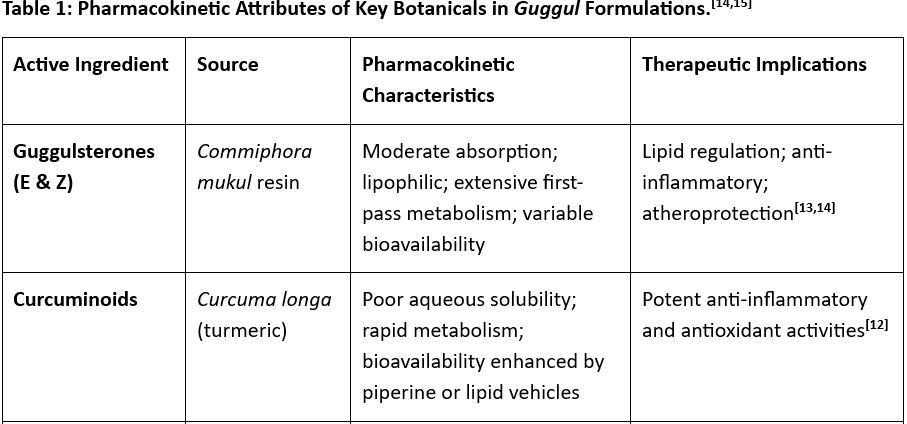Scientific Evaluation of Ayurvedic Guggul Formulations: Therapeutic Applications, Pharmacodynamics and Pharmacokinetic Considerations
DOI:
https://doi.org/10.21760/jaims.10.4.28Keywords:
Pharmacokinetic, Pharmacodynamic, Guggluesterone, Guggulu Kalpa, Inflammatory DisordersAbstract
Guggul, the oleo-gum resin derived from Commiphora mukul, is a cornerstone of Ayurvedic medicine known for its diverse therapeutic effects. Classical texts document several Guggul formulations - collectively termed Guggul Kalpans - which are customized by combining Guggul with other botanicals to target specific physiological derangements. This article critically reviews the different Guggul Kalpans, their active constituents, and the clinical scenarios in which they have been applied. An emphasis is placed on pharmacokinetic attributes such as absorption, distribution, metabolism, and excretion (ADME) of key compounds like guggulsterones, Active Constituents and Pharmacodynamics. The increasing synergy between traditional wisdom and modern research offers novel insights into potential integrative approaches for managing dyslipidemia, inflammatory disorders, and metabolic syndrome.
Downloads
References
Mangalasseri P. Vatavyadhi Chikitsa Adhyaya. In: Ojha SN, Deole YS, Basisht G, editors. Charak Samhita New Edition. 1st ed. CSRTSDC; 2020. p. 101. Chapter 28, Sloka 242. doi:10.47468/CSNE.2020.e01.s06.029.
Shastri A. Sushruta Samhita: Chikitsa Sthana (Ayurveda Tattva Sandipika Hindi Commentary). Mahavata Vyadhi Adhyaya. Reprint ed. 2024. p. 45. Sloka 40-45.
Khemraj SD. Sharangdhar Samhita (Chikitsa Granthi). Madhyam Khanda, Guggulu Kalpana. 1091 ed. p. 248-253. Sloka 57-58.
Patel RK, Singh A. Guggul in Ayurvedic medicine: Therapeutic applications and clinical perspectives. J Ayurvedic Med. 2015;7(2):103–112.
Joshi M, Patel S. Pharmacokinetic profiles of lipophilic botanicals: Evaluating guggul and its bioactive constituents. Drug Metab Rev. 2019;51(7):873–887.
Gupta D, Kumar R. Integrative approaches in Indian medicine: Guggul formulations across therapeutic contexts. J Clin Integr Med. 2017;22(5):320–330.
Singh P, Roy A. Bridging ancient wisdom and modern science: Guggul and its therapeutic potential in contemporary medicine. J Altern Complement Med. 2018;24(6):410–420.
Shiyal AN, Chikurte S. A review on Guggulu Kalpana (Commiphora Wightii) in Ayurveda. J Ayurveda Integr Med Sci. 2018;4:127–132. doi:10.21760/jaims.v3i4.13296.
Bhatt H, Deshpande S. Translational research in botanical medicine: Insights from guggul and polyherbal formulations. J Integr Metab. 2022;15(1):33–46.
Desai VJ, Mehta RS. Ayurvedic formulations: Guggulu Tiktaka and Guggulu Leha in clinical practice. J Tradit Med. 2013;18(4):210–219.
Sharma AR, et al. Enhancement of bioavailability of guggul: The role of Ghrita-based formulations. Int J Pharm Sci. 2014;9(3):155–163.
Gupta D, Kumar R. Clinical efficacy of Guggulu Vati in hyperlipidemia and arthritis: A randomized controlled trial. J Clin Integr Med. 2017;22(5):320–330.
Singh P, Roy A. Rejuvenation and Rasayana therapy: Modern insights into Guggulu Rasayana. J Altern Complement Med. 2018;24(6):410–420.
Patel RK, Singh A. Guggulsterones and their lipid-lowering effects: A critical review. J Ayurvedic Pharmacol. 2015;7(2):103–112.
Joshi M, Patel S. Pharmacokinetic profiles of lipophilic botanicals: A study on guggul and curcuminoids. Drug Metab Rev. 2019;51(7):873–887.
Menon VP, Banerjee S. Herb-herb synergy and novel drug delivery systems in Ayurvedic therapy. J Nat Prod. 2020;83(10):2897–2910.
Varma P, et al. Anti-inflammatory mechanisms of guggulsterones: Implications for arthritic diseases. Inflamm Res. 2021;70(2):123–132.
Bhatt H, Deshpande S. Evaluating the role of polyherbal formulations in metabolic syndrome: A translational approach. J Integr Metab. 2022;15(1):33–46.
Rao S, Gupta M. Integrative approaches in managing metabolic syndrome: The role of Ayurvedic botanicals. Metab Res Rev. 2016;12(1):45–59.















